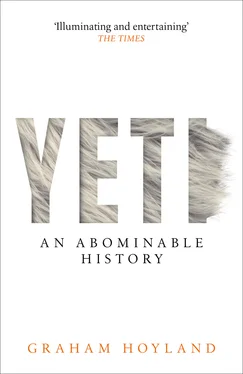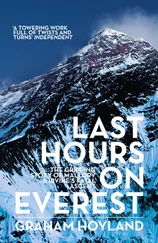Tilman suggests that the maker of the tracks had picked up a pair of discarded climbing boots from the old German base camp near Kangchenjunga, and used them to cross the Zemu Gap. ‘I have hinted that the subject of our inquiry may not be as “dumb” as we think, and we are not to assume that a Snowman has not wit enough to keep his feet dry if they happen to be the shape that fits into boots.’
Tilman’s conclusion is that something has made the strange footprints he enumerates, including the strange Rongbuk stone footprint, and that something might as well be the Abominable Snowman. There is a dubious logic about this. He concludes with a veiled threat, which we may quail at: ‘I think he would be a bold and in some ways an impious sceptic who after balancing the evidence does not decide to give him the benefit of the doubt.’
So, covered with footprints, we end Appendix B perhaps more confused than when we began it, but with a vague feeling that we’ve been hoodwinked.

My next bookish proposition has been virtually unknown to the reading public since it first appeared in 1956. ‘For most people, it appears … the funniest book they have never heard of,’ wrote Bill Bryson, in a lavish preface that puts it on a par with The Diary of a Nobody (which Evelyn Waugh, in his turn, described as ‘the funniest book in the world’). This cult book is so loved by the mountaineering tendency that it has been taken around the world by climbers and Antarctic scientists, and inspired the names of a mountain in the Masson range in Antarctica, the northeast ridge of Pikes Peak, Colorado, and (perhaps more usefully) the famous bar and restaurant in Kathmandu, Nepal. It also presents solid evidence of the ‘Atrocious Snowman’.
The Ascent of Rum Doodle is a lethal parody of the stiff-upper-lipped, tight-arsed English school of expedition literature in which the sadder of us are steeped. It is the story of a group of utter incompetents who set out to climb the world’s highest mountain, the 40,500-foot Rum Doodle, a mountain ‘celebrated but rarely seen’ (a ‘rum do’ means a strange event). It is claimed by Bryson and others that The Ascent of Rum Doodle is based on Bill Tilman’s The Ascent of Nanda Devi , but I don’t think that is entirely correct. There is already quite enough self-parody in that book: when they reach the summit, Tilman writes, ‘we so far forgot ourselves as to shake hands on it’. No, I suggest that more likely texts to be satirised are Noel Odell’s Everest, 1925 , Ralph Barker’s The Last Blue Mountain , and John Hunt’s The Ascent of Everest ; robust, militaristic accounts redounding to the credit of the writers. However, I could be wrong; you might also detect something in Rum Doodle of the underlying squabbles of Tilman’s book Mount Everest 1938 (‘we were forced to breakfast on lentils and pemmican.’)
The writer was W. E. Bowman, who seemed to have so much knowledge of high-altitude climbing that many readers assumed the name was a pseudonym for Tilman. Bowman was in fact a civil engineer who spent his time hill-walking, painting, reading rather too many expedition books and writing (unpublished) books on the Theory of Relativity. He only saw high mountains once, on a trip to Switzerland. As Bill Bryson recounts, the book did not fare well at first. One reviewer from Good Housekeeping admitted that she had got quite far in, before realising it wasn’t entirely serious. Thirty years after its publication in hardback, Arrow Books issued a paperback edition, which has to be some kind of a record. Bowman’s characters are all immediately recognisable to anyone who has been on a Himalayan expedition. They are:
Burley, the expedition leader, the strong thrusting and unsympathetic climber type.
Binder, the narrator (a Bounder, perhaps?)
Prone, the doctor, who spends the whole time lying down suffering from various appalling diseases.
Shute, the photographer, who accidentally exposes all his film stock to daylight.
Wish, the scientist, who wants to take a three-ton pneumatic geologist’s hammer, and who while testing his altitude measuring equipment during the voyage to Yogistan discovers that the ship is 153 feet above sea level.
Then there is the language expert Constant(consonant?), who manages to infuriate the leader of the 30,000 Yogistani porters by informing him that he lusted after his wife.
However, my favourite is Jungle, the navigator, who gets lost on the way to the initial expedition meeting and sends telegrams from London requesting more money when the team are on the way to the mountain. (If you think this is far-fetched, I was on one expedition to Sikkim when my leader failed to apply for the correct Indian visa and was leading the party from London while we were herding yaks up the slopes of Kangchenjunga. We also ended up climbing the wrong mountain, but that is a shameful memory I try to repress.)
There are various bungling adventures which parody events in the source books. The members wander in the fog, coming across their own footprints and re-encountering each other until they realise that Jungle’s compass is locked on north and they are walking in circles. They have the obligatory fall into a crevasse, a mainstay of expedition books, except that the rescue team remain at the bottom demanding further supplies of ‘medicinal’ champagne. There is even a curious homo-erotic passage which I think may refer to Gerald and Rupert’s naked wrestling match in D. H. Lawrence’s Women in Love . The narrator Binder and Constant are lying close together in a high-altitude tent:
I awoke suddenly under the impression that a prehistoric monster had crept into the tent and was about to do me an injury. I seized the nearest solid object – which happened to be a climbing boot – and hit the monster as hard as I could. It was Constant, of course. I asked if I had woken him; and if he said what I thought he said he is not the man I thought he is … Constant flung himself on me. Still dazed by sleep and terror I fought back madly, and we were wrestling all over the tent … we were locked in a complicated embrace, half in and half out of our sleeping bags, with ropes and clothing wrapped around us … ‘This can’t go on,’ said Constant. 26
In an attempt to escape the dreadful cooking of the cook, Pong, the team ascend the mountain:
We were naturally all agog to catch sight of the Atrocious Snowman, about whom so much has been written. This creature was first seen by Thudd in 1928 near the summit of Raw Deedle. He describes it as a man-like creature about seven feet [tall] covered with blue fur and having three ears. It emitted a thin whistle and ran off with incredible rapidity. The next reported encounter took place during the 1931 Bavarian reconnaissance expedition to Hi Hurdle. On this occasion it was seen by three members at a height of 25,000 feet. Their impressions are largely contradictory, but all agree that the thing wore trousers. In 1933 Orgrind and Stretcher found footprints on a snow slope above the Trundling La, and the following year Moodles heard grunts at 30,000 feet. Nothing further was reported until 1946, when Brewbody was fortunate enough to see the creature at close quarters. It was, he said, completely bare of either fur or hair, and resembled a human being of normal stature. It wore a loincloth and was talking to itself in Rudistani with a strong Birmingham accent. When it caught sight of Brewbody it sprang to the top of a crag and disappeared.
Читать дальше












